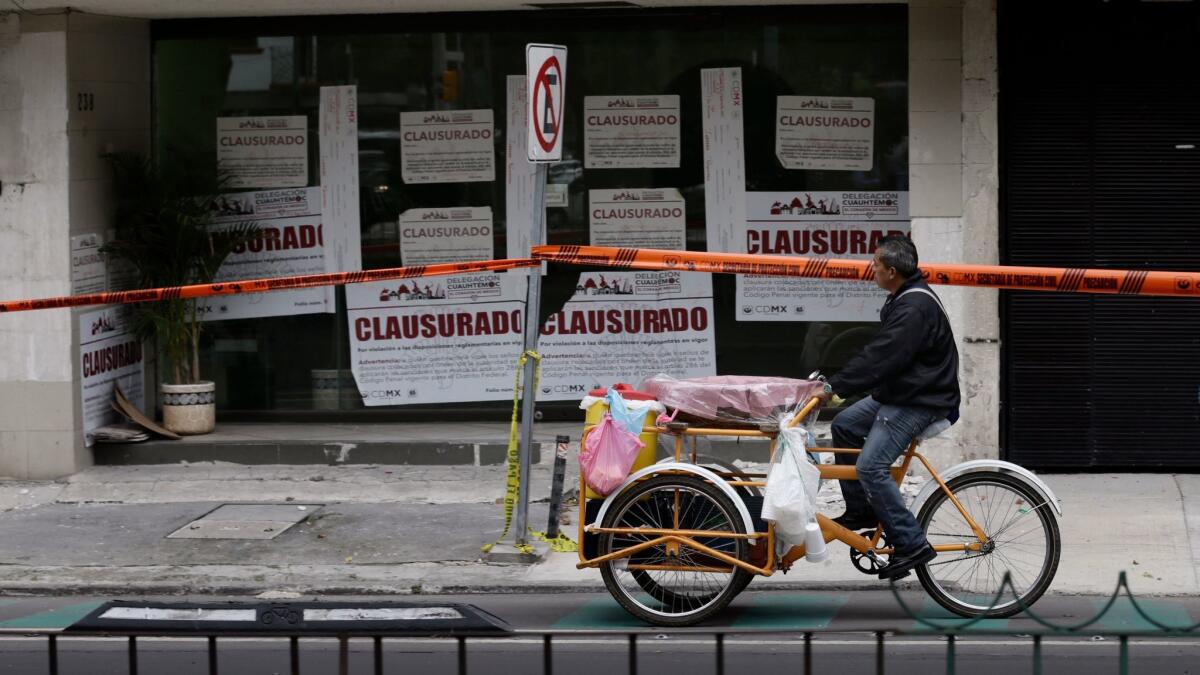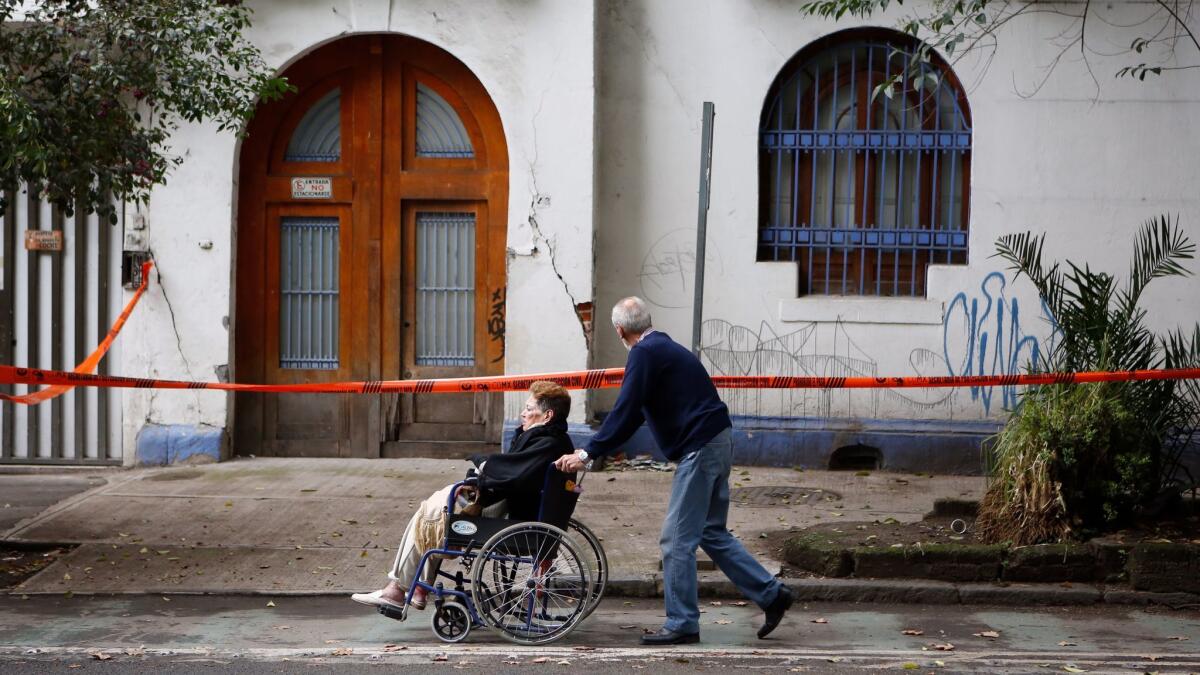Residents are fleeing Mexico City’s hippest neighborhoods amid earthquake fears

- Share via
Reporting from Mexico City — The moving vans come every day, idling outside some of Mexico City’s chicest apartment buildings before hauling away books, furniture and clothes.
More than a month after a magnitude 7.1 earthquake rattled the Mexican capital, some residents are fleeing the city’s famous districts in search of steadier ground. Even some whose homes were unscathed are leaving, unnerved by the sight of their neighborhoods transformed into disaster zones.
For decades, the leafy enclaves in the heart of the city were among the country’s most desirable — and expensive. Condesa, a bohemian oasis, was known for its Art Deco architecture and crowded outdoor cafes. Neighboring Roma was a brasher, younger district, where fashionistas in their 20s packed art-house cinemas and competed with tourists for tables at world-renowned restaurants.
But there was a downside to the neighborhoods, one overlooked in recent years by eager real estate developers and residents dazzled by tree-lined avenues, hip clothing stores and eateries serving top-notch foodie cuisine.
Like other stretches of central Mexico City, these ones were built atop a shifting, dry lake bed. When the earthquake struck Sept. 19, multiple buildings in Roma and Condesa collapsed. Dozens of people died, including 49 in a single office building.
More than 50 buildings have been declared uninhabitable in the district that includes Roma and Condesa as well as the rapidly gentrifying neighborhoods of Juarez and Centro. Many other structures are still awaiting inspections by engineers who will decide whether it’s safe for occupants to return.

It’s not the first time an earthquake devastated Mexico City’s central core. The area suffered even worse destruction during the powerful earthquake in 1985, with Roma hit especially hard. An exodus to safer suburbs followed, causing property values to plummet and crime to rise.
Now, apartment, restaurant and shop owners in the neighborhoods are worried it could happen again.
“I’ve got a lot of tenants leaving Condesa even if their property is in good shape just because they’re scared,” said Gabriela Navarrete, who co-owns a real estate firm called 2aguas with a focus on the city center.
“A lot of them are moving out of the city,” she said. “They’re moving to places where buildings were not hurt.”
The departure of some residents and the multitude of roped-off buildings with broken windows and cracked facades have created an eerie atmosphere in the hardest-hit parts of Roma and Condesa.
On a recent Friday afternoon, many restaurant tables in the heart of Condesa sat empty — a sharp contrast to the usual scene before the earthquake when hordes of young professionals would be getting a head start on the weekend, dining on gourmet tacos or burgers and sipping well-aged tequila.

Fresh memories of the earthquake’s destruction make it difficult for diners to relax and have a good time, said Fernando Gasca, a 23-year-old waiter at a pizzeria called Ardente.
Across the street were the remains of a seven-story apartment building. Most of the debris had been cleared away, leaving only the ruins of a parking garage. All around, people had lighted candles and left flowers for the several people who died there.
“You come to a restaurant to enjoy yourself and enjoy your food,” Gasca said. “It’s a little hard with this in front of you.”
He was serving lunch when the temblor struck shortly after 1 p.m. He fled outside, only to watch the apartment building sway violently and then collapse with a deafening roar. The plume of dust was so thick he couldn’t see where he was running. As it began to settle, he used a fallen tree to climb up to the top of the rubble and help rescue a man who was badly injured.
The restaurant reopened after two weeks, once again offering Neapolitan-style pies and cocktails mixed at a marble bar, but few customers have returned. On a normal night before the quake, waiters would be juggling 40 tables. Now they serve just six or eight.
“It’s so depressing to see this happen to a neighborhood that was so full of life,” Gasca said. “Businesses will be forced to close. The neighborhood will change.”
Some with vested interests in the area are mounting efforts to stop that.
A public relations firm whose Condesa office was badly damaged recently launched a Twitter campaign with the hashtag #I’mStayingHere. A coalition of restaurants and shops has come together to try to bring business back.
What is needed is more government help, said Christina Lopez Medina, who for the last 54 years has run a small hair and nail salon on a quiet street in Condesa. For weeks after the earthquake, the street was overtaken by armored military vehicles and cranes as soldiers and marines searched for survivors and then bodies in a fallen building.
Since she reopened the shop, she’s been lucky to get a single customer a day.
Her landlord gave her a break on October’s rent, but Lopez doesn’t know what she’ll do this month. The city government has promised small-business loans, but she doesn’t trust it will follow through.
Lopez, 76, survived the 1985 earthquake, and believes that in time, her clients will return. For now, she’s taking antidepressants and hoping for the best. She has been showing up to work, she said, because she knows people need signs of normality. “I want to be here so people see me here,” she said.

But in so many places, sadness remains. Amsterdam, a verdant avenue typically bustling with joggers and people walking their dogs, is now lined with bright orange Day of the Dead flowers. In nearby Parque Mexico, a tree-filled labyrinth of walking paths that some describe as the neighborhood’s “lungs,” there is a flower-strewn altar for a woman named Mar who died nearby.
On a recent cool fall day, as leaves fell and blew in the wind, Monica Garibi, a 35-year-old lawyer who lives in Condesa, led her mother, visiting from out of town, on a walking tour of some of the damage.
They gasped as they beheld a cordoned-off building that was tilting dangerously toward the street. The children’s clothing store and popular falafel shop on the ground level had been shuttered. A sleepy security officer stood guard nearby against looters.
Garibi’s three-story apartment building was fine, but the nearby headquarters of the nonprofit where she works had been damaged. “No one wants to go back to work there,” she said.
Some of her friends were leaving, moving to areas off the lake bed.
She didn’t know what to do. When her lease comes up in several months, she’d decide whether to move. On the one hand, she was feeling more optimistic about the neighborhood. “The trauma is fading,” she said. “Every day I feel calmer.”
Still, she had moments of feeling on edge and was hyper-vigilant for any signs of another earthquake. Any time the earth shook — say from a passing truck — she wondered whether it was happening again.
Twitter: @katelinthicum
Cecilia Sanchez in the Times’ Mexico City bureau contributed to this report.
ALSO
The U.S. and Mexico want to slow migration from Central America. Will mass deportations help?
Mexico City prosecutors open criminal inquiries into buildings damaged in the deadly earthquake
More to Read
Sign up for Essential California
The most important California stories and recommendations in your inbox every morning.
You may occasionally receive promotional content from the Los Angeles Times.














